Strategic Planning and Analysis: A Business Report on Sainsbury's
VerifiedAdded on 2023/01/12
|17
|4739
|43
Report
AI Summary
This report provides a comprehensive analysis of Sainsbury's business strategy, examining the impact of macro-environmental factors, including political, economic, social, technological, legal, and environmental influences, using frameworks like PESTLE and stakeholder analysis. It delves into Sainsbury's internal environment, utilizing the McKinsey 7S and VRIO models to assess capabilities and resources. The report also applies Porter's five forces model to evaluate the competitive landscape and interprets strategic planning through various theories and models, culminating in a discussion of Sainsbury's strengths, weaknesses, opportunities, and threats (SWOT). The analysis covers various strategic planning techniques like benchmarking and business analysis, offering insights into Sainsbury's approach to maintain a competitive advantage in the UK supermarket industry.
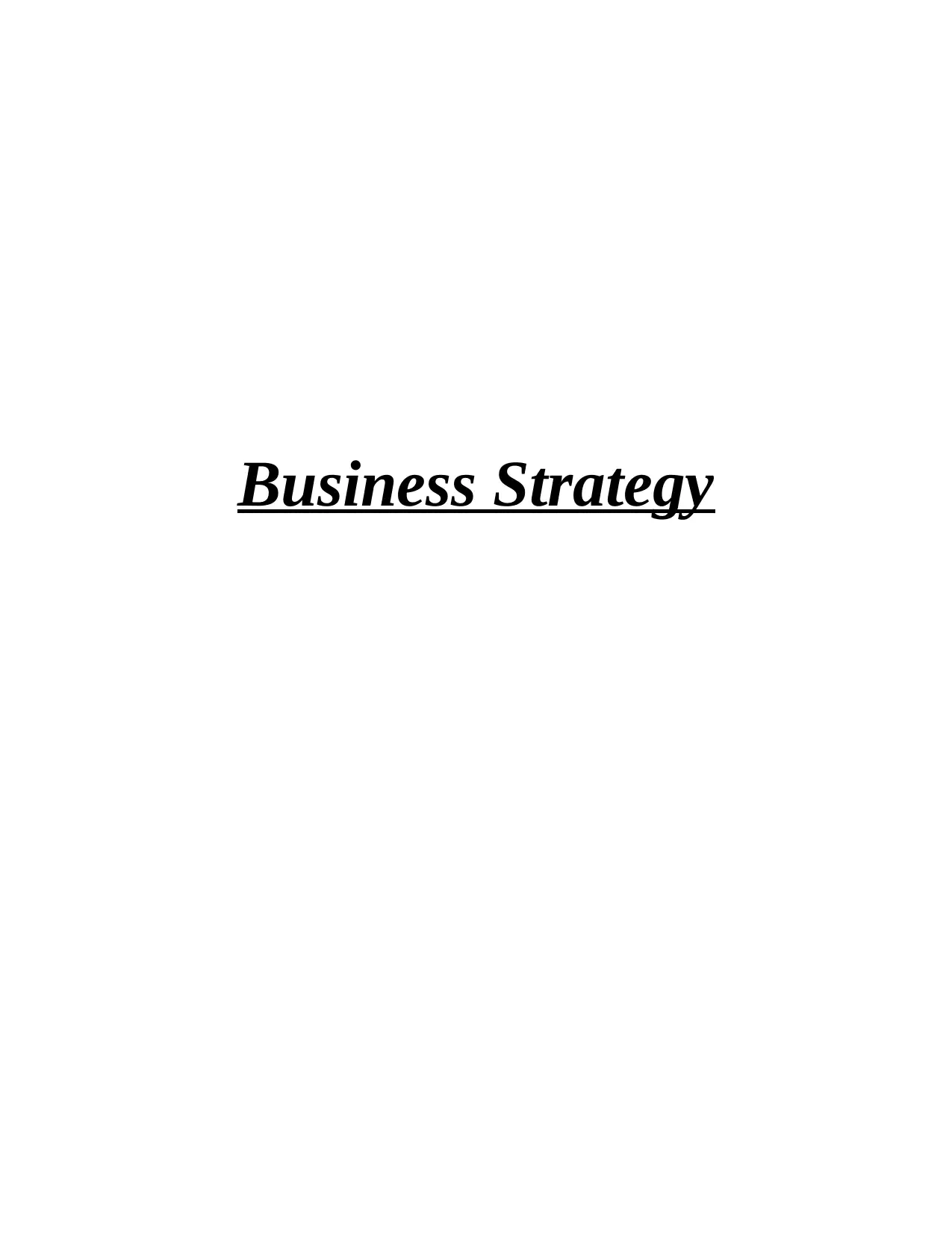
Business Strategy
Paraphrase This Document
Need a fresh take? Get an instant paraphrase of this document with our AI Paraphraser
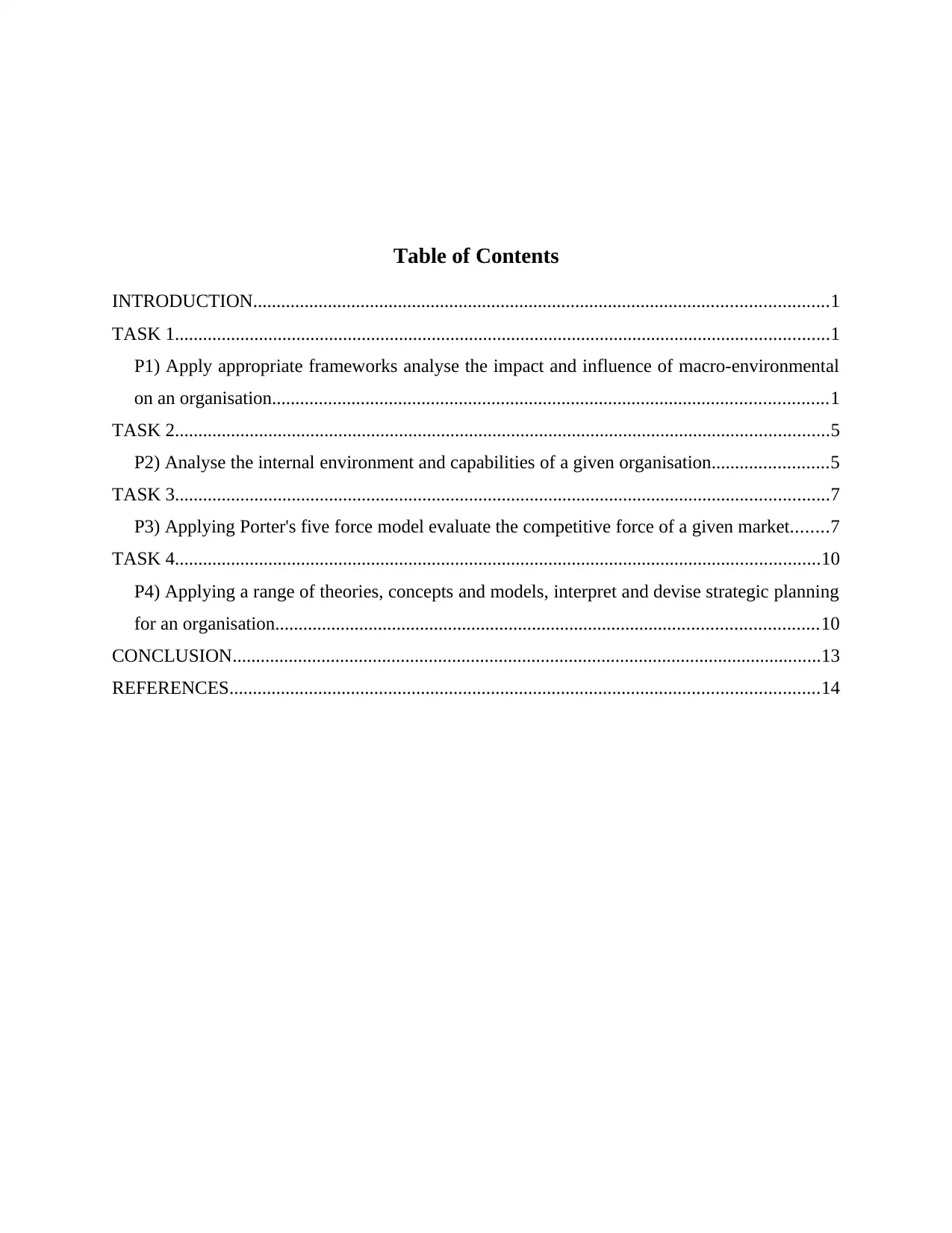
Table of Contents
INTRODUCTION...........................................................................................................................1
TASK 1............................................................................................................................................1
P1) Apply appropriate frameworks analyse the impact and influence of macro-environmental
on an organisation.......................................................................................................................1
TASK 2............................................................................................................................................5
P2) Analyse the internal environment and capabilities of a given organisation.........................5
TASK 3............................................................................................................................................7
P3) Applying Porter's five force model evaluate the competitive force of a given market........7
TASK 4..........................................................................................................................................10
P4) Applying a range of theories, concepts and models, interpret and devise strategic planning
for an organisation....................................................................................................................10
CONCLUSION..............................................................................................................................13
REFERENCES..............................................................................................................................14
INTRODUCTION...........................................................................................................................1
TASK 1............................................................................................................................................1
P1) Apply appropriate frameworks analyse the impact and influence of macro-environmental
on an organisation.......................................................................................................................1
TASK 2............................................................................................................................................5
P2) Analyse the internal environment and capabilities of a given organisation.........................5
TASK 3............................................................................................................................................7
P3) Applying Porter's five force model evaluate the competitive force of a given market........7
TASK 4..........................................................................................................................................10
P4) Applying a range of theories, concepts and models, interpret and devise strategic planning
for an organisation....................................................................................................................10
CONCLUSION..............................................................................................................................13
REFERENCES..............................................................................................................................14
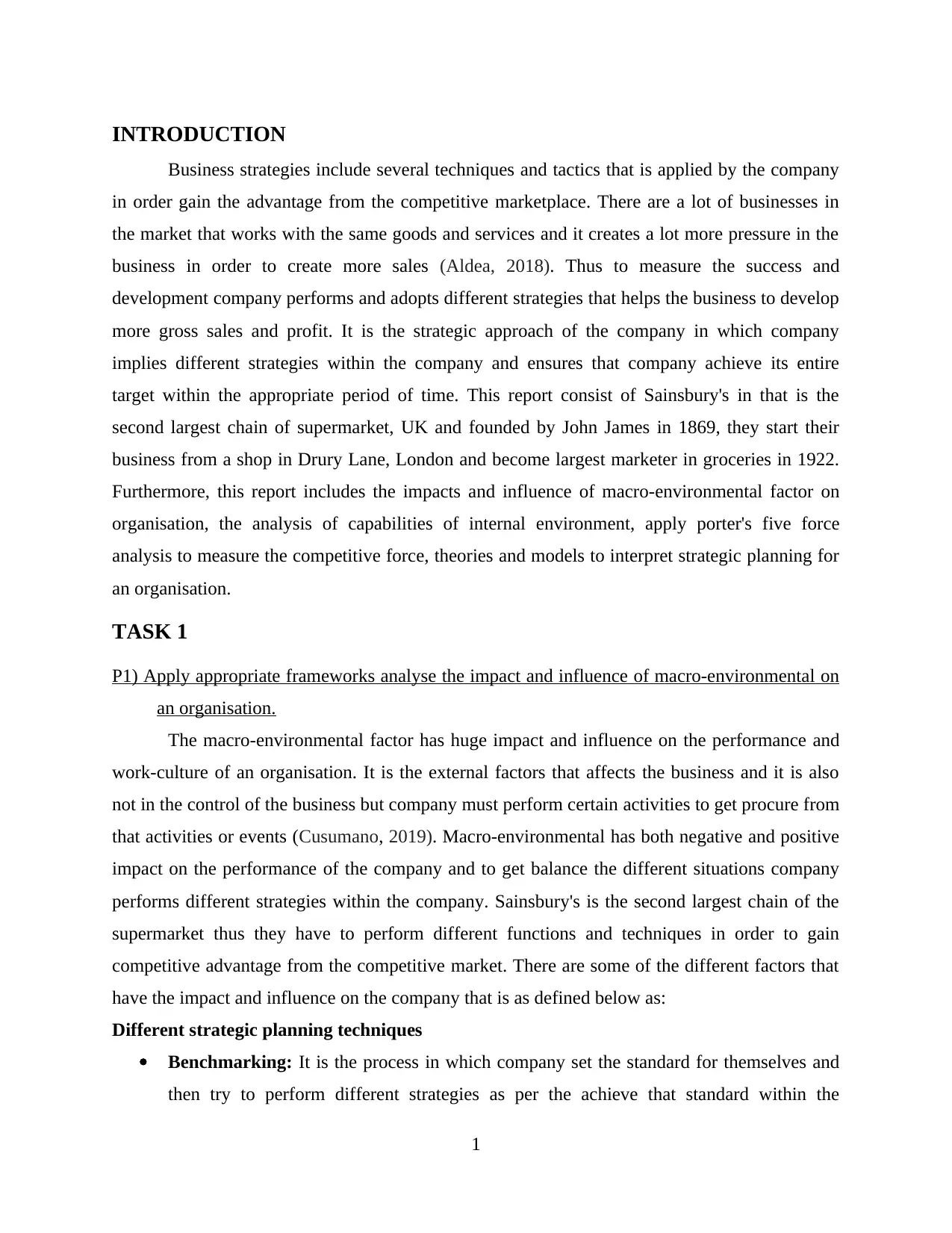
INTRODUCTION
Business strategies include several techniques and tactics that is applied by the company
in order gain the advantage from the competitive marketplace. There are a lot of businesses in
the market that works with the same goods and services and it creates a lot more pressure in the
business in order to create more sales (Aldea, 2018). Thus to measure the success and
development company performs and adopts different strategies that helps the business to develop
more gross sales and profit. It is the strategic approach of the company in which company
implies different strategies within the company and ensures that company achieve its entire
target within the appropriate period of time. This report consist of Sainsbury's in that is the
second largest chain of supermarket, UK and founded by John James in 1869, they start their
business from a shop in Drury Lane, London and become largest marketer in groceries in 1922.
Furthermore, this report includes the impacts and influence of macro-environmental factor on
organisation, the analysis of capabilities of internal environment, apply porter's five force
analysis to measure the competitive force, theories and models to interpret strategic planning for
an organisation.
TASK 1
P1) Apply appropriate frameworks analyse the impact and influence of macro-environmental on
an organisation.
The macro-environmental factor has huge impact and influence on the performance and
work-culture of an organisation. It is the external factors that affects the business and it is also
not in the control of the business but company must perform certain activities to get procure from
that activities or events (Cusumano, 2019). Macro-environmental has both negative and positive
impact on the performance of the company and to get balance the different situations company
performs different strategies within the company. Sainsbury's is the second largest chain of the
supermarket thus they have to perform different functions and techniques in order to gain
competitive advantage from the competitive market. There are some of the different factors that
have the impact and influence on the company that is as defined below as:
Different strategic planning techniques
Benchmarking: It is the process in which company set the standard for themselves and
then try to perform different strategies as per the achieve that standard within the
1
Business strategies include several techniques and tactics that is applied by the company
in order gain the advantage from the competitive marketplace. There are a lot of businesses in
the market that works with the same goods and services and it creates a lot more pressure in the
business in order to create more sales (Aldea, 2018). Thus to measure the success and
development company performs and adopts different strategies that helps the business to develop
more gross sales and profit. It is the strategic approach of the company in which company
implies different strategies within the company and ensures that company achieve its entire
target within the appropriate period of time. This report consist of Sainsbury's in that is the
second largest chain of supermarket, UK and founded by John James in 1869, they start their
business from a shop in Drury Lane, London and become largest marketer in groceries in 1922.
Furthermore, this report includes the impacts and influence of macro-environmental factor on
organisation, the analysis of capabilities of internal environment, apply porter's five force
analysis to measure the competitive force, theories and models to interpret strategic planning for
an organisation.
TASK 1
P1) Apply appropriate frameworks analyse the impact and influence of macro-environmental on
an organisation.
The macro-environmental factor has huge impact and influence on the performance and
work-culture of an organisation. It is the external factors that affects the business and it is also
not in the control of the business but company must perform certain activities to get procure from
that activities or events (Cusumano, 2019). Macro-environmental has both negative and positive
impact on the performance of the company and to get balance the different situations company
performs different strategies within the company. Sainsbury's is the second largest chain of the
supermarket thus they have to perform different functions and techniques in order to gain
competitive advantage from the competitive market. There are some of the different factors that
have the impact and influence on the company that is as defined below as:
Different strategic planning techniques
Benchmarking: It is the process in which company set the standard for themselves and
then try to perform different strategies as per the achieve that standard within the
1
⊘ This is a preview!⊘
Do you want full access?
Subscribe today to unlock all pages.

Trusted by 1+ million students worldwide
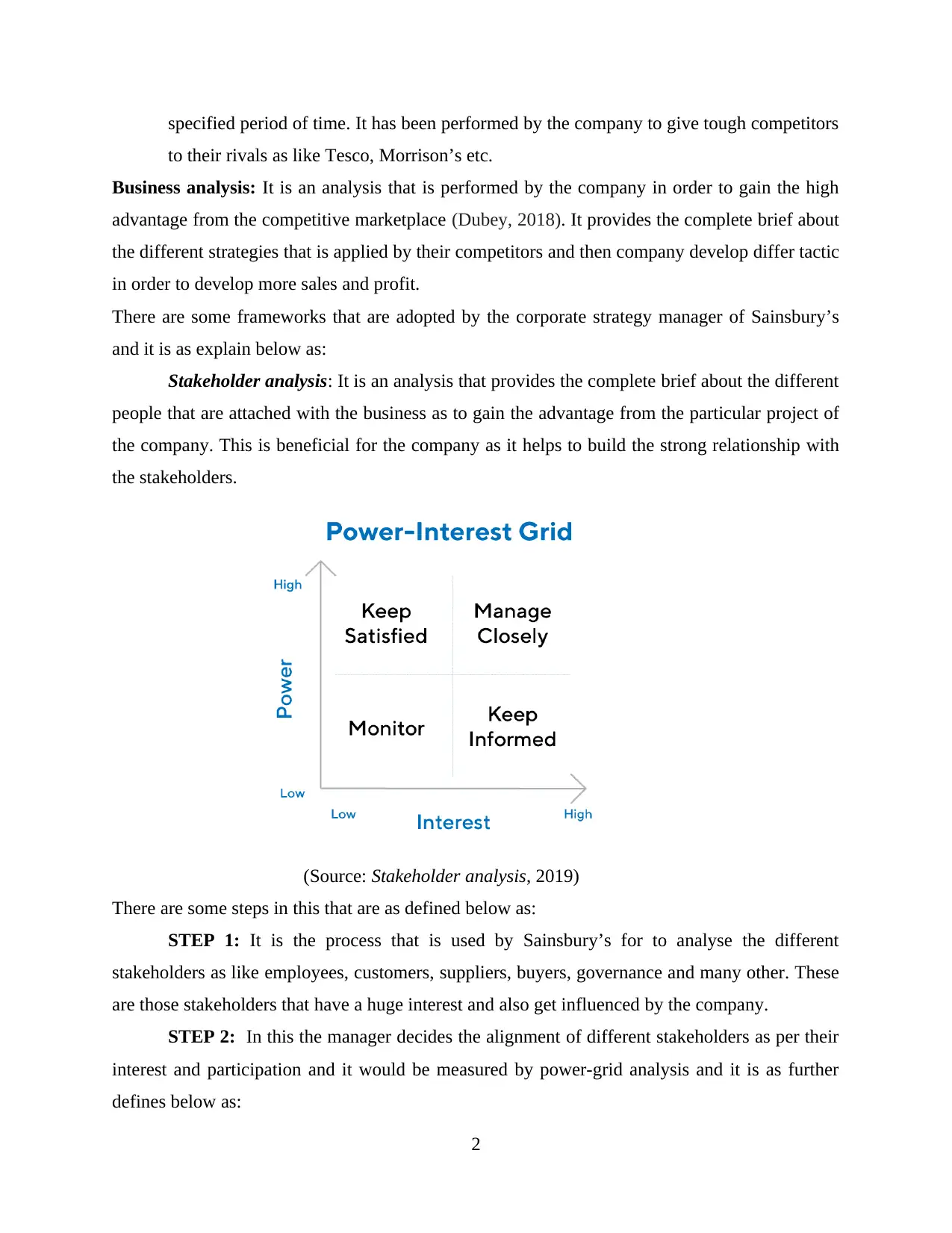
specified period of time. It has been performed by the company to give tough competitors
to their rivals as like Tesco, Morrison’s etc.
Business analysis: It is an analysis that is performed by the company in order to gain the high
advantage from the competitive marketplace (Dubey, 2018). It provides the complete brief about
the different strategies that is applied by their competitors and then company develop differ tactic
in order to develop more sales and profit.
There are some frameworks that are adopted by the corporate strategy manager of Sainsbury’s
and it is as explain below as:
Stakeholder analysis: It is an analysis that provides the complete brief about the different
people that are attached with the business as to gain the advantage from the particular project of
the company. This is beneficial for the company as it helps to build the strong relationship with
the stakeholders.
(Source: Stakeholder analysis, 2019)
There are some steps in this that are as defined below as:
STEP 1: It is the process that is used by Sainsbury’s for to analyse the different
stakeholders as like employees, customers, suppliers, buyers, governance and many other. These
are those stakeholders that have a huge interest and also get influenced by the company.
STEP 2: In this the manager decides the alignment of different stakeholders as per their
interest and participation and it would be measured by power-grid analysis and it is as further
defines below as:
2
to their rivals as like Tesco, Morrison’s etc.
Business analysis: It is an analysis that is performed by the company in order to gain the high
advantage from the competitive marketplace (Dubey, 2018). It provides the complete brief about
the different strategies that is applied by their competitors and then company develop differ tactic
in order to develop more sales and profit.
There are some frameworks that are adopted by the corporate strategy manager of Sainsbury’s
and it is as explain below as:
Stakeholder analysis: It is an analysis that provides the complete brief about the different
people that are attached with the business as to gain the advantage from the particular project of
the company. This is beneficial for the company as it helps to build the strong relationship with
the stakeholders.
(Source: Stakeholder analysis, 2019)
There are some steps in this that are as defined below as:
STEP 1: It is the process that is used by Sainsbury’s for to analyse the different
stakeholders as like employees, customers, suppliers, buyers, governance and many other. These
are those stakeholders that have a huge interest and also get influenced by the company.
STEP 2: In this the manager decides the alignment of different stakeholders as per their
interest and participation and it would be measured by power-grid analysis and it is as further
defines below as:
2
Paraphrase This Document
Need a fresh take? Get an instant paraphrase of this document with our AI Paraphraser
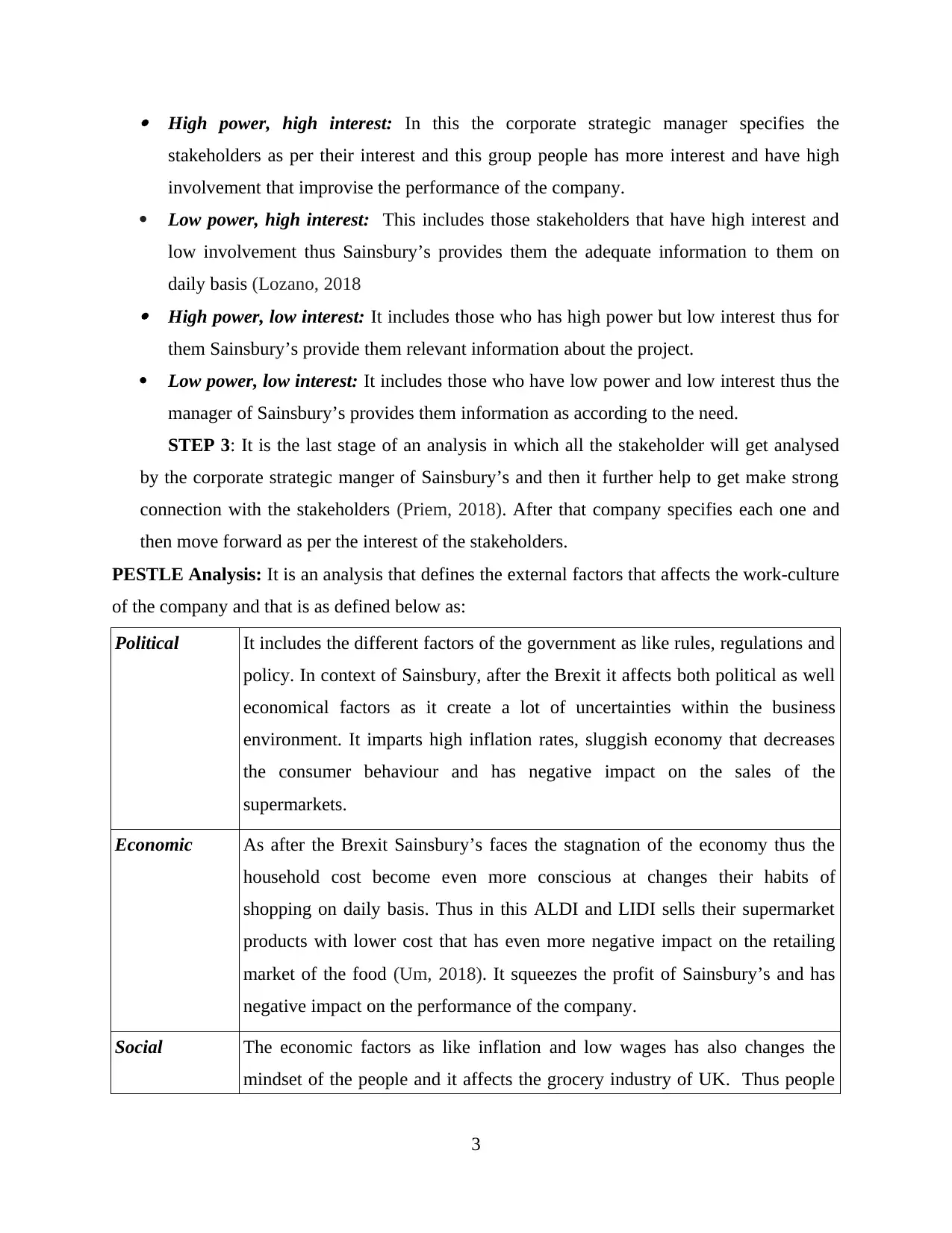
High power, high interest: In this the corporate strategic manager specifies the
stakeholders as per their interest and this group people has more interest and have high
involvement that improvise the performance of the company.
Low power, high interest: This includes those stakeholders that have high interest and
low involvement thus Sainsbury’s provides them the adequate information to them on
daily basis (Lozano, 2018 High power, low interest: It includes those who has high power but low interest thus for
them Sainsbury’s provide them relevant information about the project.
Low power, low interest: It includes those who have low power and low interest thus the
manager of Sainsbury’s provides them information as according to the need.
STEP 3: It is the last stage of an analysis in which all the stakeholder will get analysed
by the corporate strategic manger of Sainsbury’s and then it further help to get make strong
connection with the stakeholders (Priem, 2018). After that company specifies each one and
then move forward as per the interest of the stakeholders.
PESTLE Analysis: It is an analysis that defines the external factors that affects the work-culture
of the company and that is as defined below as:
Political It includes the different factors of the government as like rules, regulations and
policy. In context of Sainsbury, after the Brexit it affects both political as well
economical factors as it create a lot of uncertainties within the business
environment. It imparts high inflation rates, sluggish economy that decreases
the consumer behaviour and has negative impact on the sales of the
supermarkets.
Economic As after the Brexit Sainsbury’s faces the stagnation of the economy thus the
household cost become even more conscious at changes their habits of
shopping on daily basis. Thus in this ALDI and LIDI sells their supermarket
products with lower cost that has even more negative impact on the retailing
market of the food (Um, 2018). It squeezes the profit of Sainsbury’s and has
negative impact on the performance of the company.
Social The economic factors as like inflation and low wages has also changes the
mindset of the people and it affects the grocery industry of UK. Thus people
3
stakeholders as per their interest and this group people has more interest and have high
involvement that improvise the performance of the company.
Low power, high interest: This includes those stakeholders that have high interest and
low involvement thus Sainsbury’s provides them the adequate information to them on
daily basis (Lozano, 2018 High power, low interest: It includes those who has high power but low interest thus for
them Sainsbury’s provide them relevant information about the project.
Low power, low interest: It includes those who have low power and low interest thus the
manager of Sainsbury’s provides them information as according to the need.
STEP 3: It is the last stage of an analysis in which all the stakeholder will get analysed
by the corporate strategic manger of Sainsbury’s and then it further help to get make strong
connection with the stakeholders (Priem, 2018). After that company specifies each one and
then move forward as per the interest of the stakeholders.
PESTLE Analysis: It is an analysis that defines the external factors that affects the work-culture
of the company and that is as defined below as:
Political It includes the different factors of the government as like rules, regulations and
policy. In context of Sainsbury, after the Brexit it affects both political as well
economical factors as it create a lot of uncertainties within the business
environment. It imparts high inflation rates, sluggish economy that decreases
the consumer behaviour and has negative impact on the sales of the
supermarkets.
Economic As after the Brexit Sainsbury’s faces the stagnation of the economy thus the
household cost become even more conscious at changes their habits of
shopping on daily basis. Thus in this ALDI and LIDI sells their supermarket
products with lower cost that has even more negative impact on the retailing
market of the food (Um, 2018). It squeezes the profit of Sainsbury’s and has
negative impact on the performance of the company.
Social The economic factors as like inflation and low wages has also changes the
mindset of the people and it affects the grocery industry of UK. Thus people
3
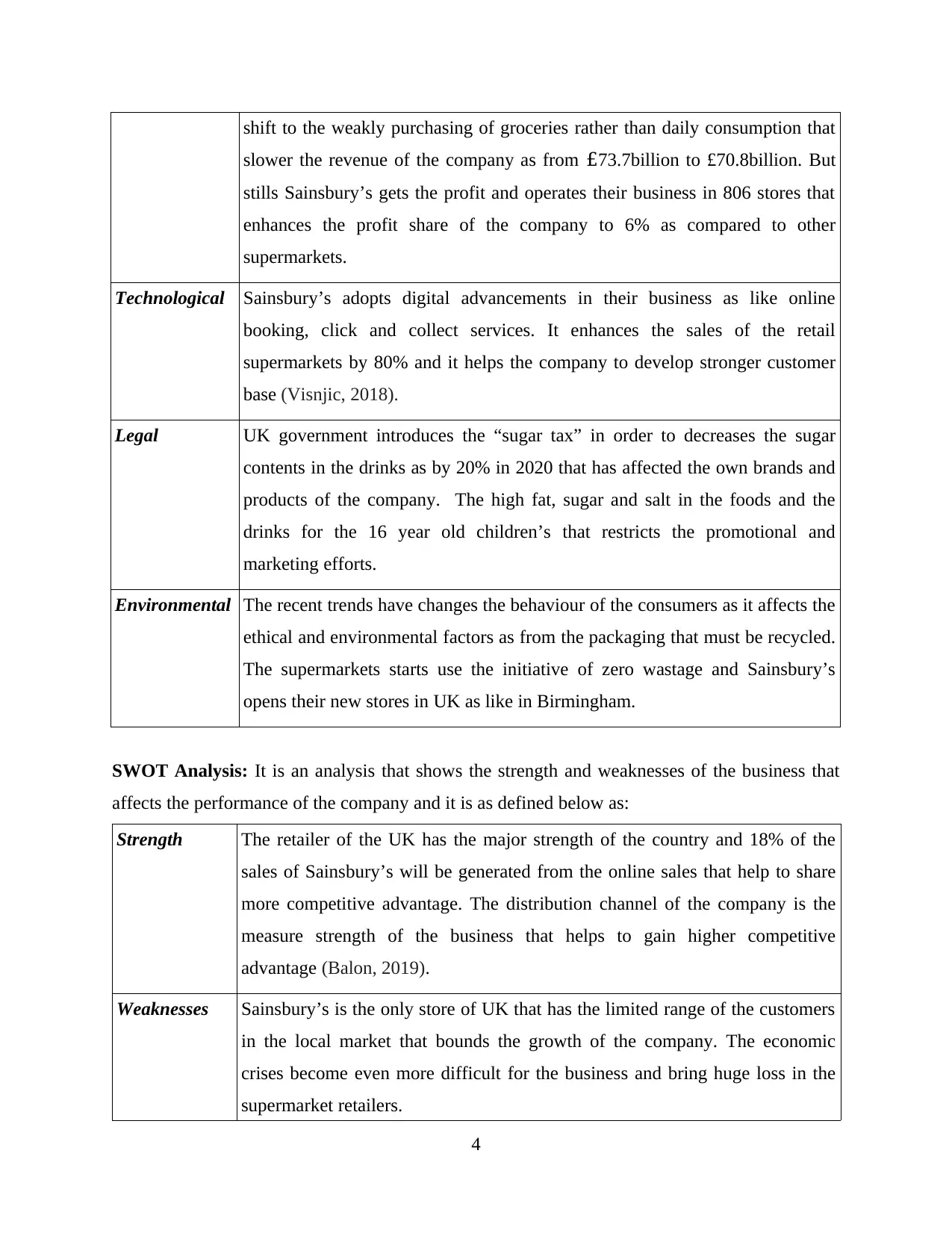
shift to the weakly purchasing of groceries rather than daily consumption that
slower the revenue of the company as from £73.7billion to £70.8billion. But
stills Sainsbury’s gets the profit and operates their business in 806 stores that
enhances the profit share of the company to 6% as compared to other
supermarkets.
Technological Sainsbury’s adopts digital advancements in their business as like online
booking, click and collect services. It enhances the sales of the retail
supermarkets by 80% and it helps the company to develop stronger customer
base (Visnjic, 2018).
Legal UK government introduces the “sugar tax” in order to decreases the sugar
contents in the drinks as by 20% in 2020 that has affected the own brands and
products of the company. The high fat, sugar and salt in the foods and the
drinks for the 16 year old children’s that restricts the promotional and
marketing efforts.
Environmental The recent trends have changes the behaviour of the consumers as it affects the
ethical and environmental factors as from the packaging that must be recycled.
The supermarkets starts use the initiative of zero wastage and Sainsbury’s
opens their new stores in UK as like in Birmingham.
SWOT Analysis: It is an analysis that shows the strength and weaknesses of the business that
affects the performance of the company and it is as defined below as:
Strength The retailer of the UK has the major strength of the country and 18% of the
sales of Sainsbury’s will be generated from the online sales that help to share
more competitive advantage. The distribution channel of the company is the
measure strength of the business that helps to gain higher competitive
advantage (Balon, 2019).
Weaknesses Sainsbury’s is the only store of UK that has the limited range of the customers
in the local market that bounds the growth of the company. The economic
crises become even more difficult for the business and bring huge loss in the
supermarket retailers.
4
slower the revenue of the company as from £73.7billion to £70.8billion. But
stills Sainsbury’s gets the profit and operates their business in 806 stores that
enhances the profit share of the company to 6% as compared to other
supermarkets.
Technological Sainsbury’s adopts digital advancements in their business as like online
booking, click and collect services. It enhances the sales of the retail
supermarkets by 80% and it helps the company to develop stronger customer
base (Visnjic, 2018).
Legal UK government introduces the “sugar tax” in order to decreases the sugar
contents in the drinks as by 20% in 2020 that has affected the own brands and
products of the company. The high fat, sugar and salt in the foods and the
drinks for the 16 year old children’s that restricts the promotional and
marketing efforts.
Environmental The recent trends have changes the behaviour of the consumers as it affects the
ethical and environmental factors as from the packaging that must be recycled.
The supermarkets starts use the initiative of zero wastage and Sainsbury’s
opens their new stores in UK as like in Birmingham.
SWOT Analysis: It is an analysis that shows the strength and weaknesses of the business that
affects the performance of the company and it is as defined below as:
Strength The retailer of the UK has the major strength of the country and 18% of the
sales of Sainsbury’s will be generated from the online sales that help to share
more competitive advantage. The distribution channel of the company is the
measure strength of the business that helps to gain higher competitive
advantage (Balon, 2019).
Weaknesses Sainsbury’s is the only store of UK that has the limited range of the customers
in the local market that bounds the growth of the company. The economic
crises become even more difficult for the business and bring huge loss in the
supermarket retailers.
4
⊘ This is a preview!⊘
Do you want full access?
Subscribe today to unlock all pages.

Trusted by 1+ million students worldwide
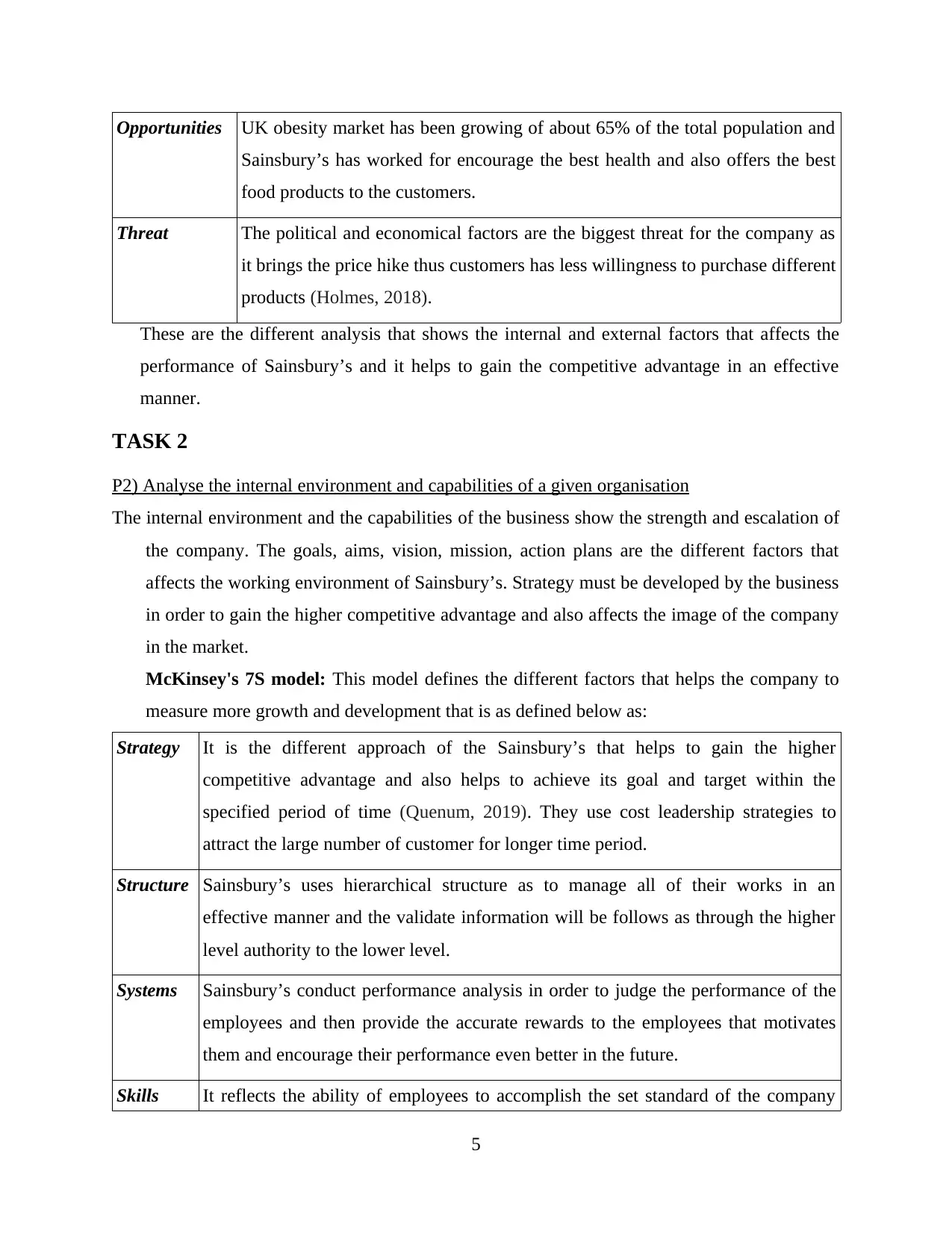
Opportunities UK obesity market has been growing of about 65% of the total population and
Sainsbury’s has worked for encourage the best health and also offers the best
food products to the customers.
Threat The political and economical factors are the biggest threat for the company as
it brings the price hike thus customers has less willingness to purchase different
products (Holmes, 2018).
These are the different analysis that shows the internal and external factors that affects the
performance of Sainsbury’s and it helps to gain the competitive advantage in an effective
manner.
TASK 2
P2) Analyse the internal environment and capabilities of a given organisation
The internal environment and the capabilities of the business show the strength and escalation of
the company. The goals, aims, vision, mission, action plans are the different factors that
affects the working environment of Sainsbury’s. Strategy must be developed by the business
in order to gain the higher competitive advantage and also affects the image of the company
in the market.
McKinsey's 7S model: This model defines the different factors that helps the company to
measure more growth and development that is as defined below as:
Strategy It is the different approach of the Sainsbury’s that helps to gain the higher
competitive advantage and also helps to achieve its goal and target within the
specified period of time (Quenum, 2019). They use cost leadership strategies to
attract the large number of customer for longer time period.
Structure Sainsbury’s uses hierarchical structure as to manage all of their works in an
effective manner and the validate information will be follows as through the higher
level authority to the lower level.
Systems Sainsbury’s conduct performance analysis in order to judge the performance of the
employees and then provide the accurate rewards to the employees that motivates
them and encourage their performance even better in the future.
Skills It reflects the ability of employees to accomplish the set standard of the company
5
Sainsbury’s has worked for encourage the best health and also offers the best
food products to the customers.
Threat The political and economical factors are the biggest threat for the company as
it brings the price hike thus customers has less willingness to purchase different
products (Holmes, 2018).
These are the different analysis that shows the internal and external factors that affects the
performance of Sainsbury’s and it helps to gain the competitive advantage in an effective
manner.
TASK 2
P2) Analyse the internal environment and capabilities of a given organisation
The internal environment and the capabilities of the business show the strength and escalation of
the company. The goals, aims, vision, mission, action plans are the different factors that
affects the working environment of Sainsbury’s. Strategy must be developed by the business
in order to gain the higher competitive advantage and also affects the image of the company
in the market.
McKinsey's 7S model: This model defines the different factors that helps the company to
measure more growth and development that is as defined below as:
Strategy It is the different approach of the Sainsbury’s that helps to gain the higher
competitive advantage and also helps to achieve its goal and target within the
specified period of time (Quenum, 2019). They use cost leadership strategies to
attract the large number of customer for longer time period.
Structure Sainsbury’s uses hierarchical structure as to manage all of their works in an
effective manner and the validate information will be follows as through the higher
level authority to the lower level.
Systems Sainsbury’s conduct performance analysis in order to judge the performance of the
employees and then provide the accurate rewards to the employees that motivates
them and encourage their performance even better in the future.
Skills It reflects the ability of employees to accomplish the set standard of the company
5
Paraphrase This Document
Need a fresh take? Get an instant paraphrase of this document with our AI Paraphraser
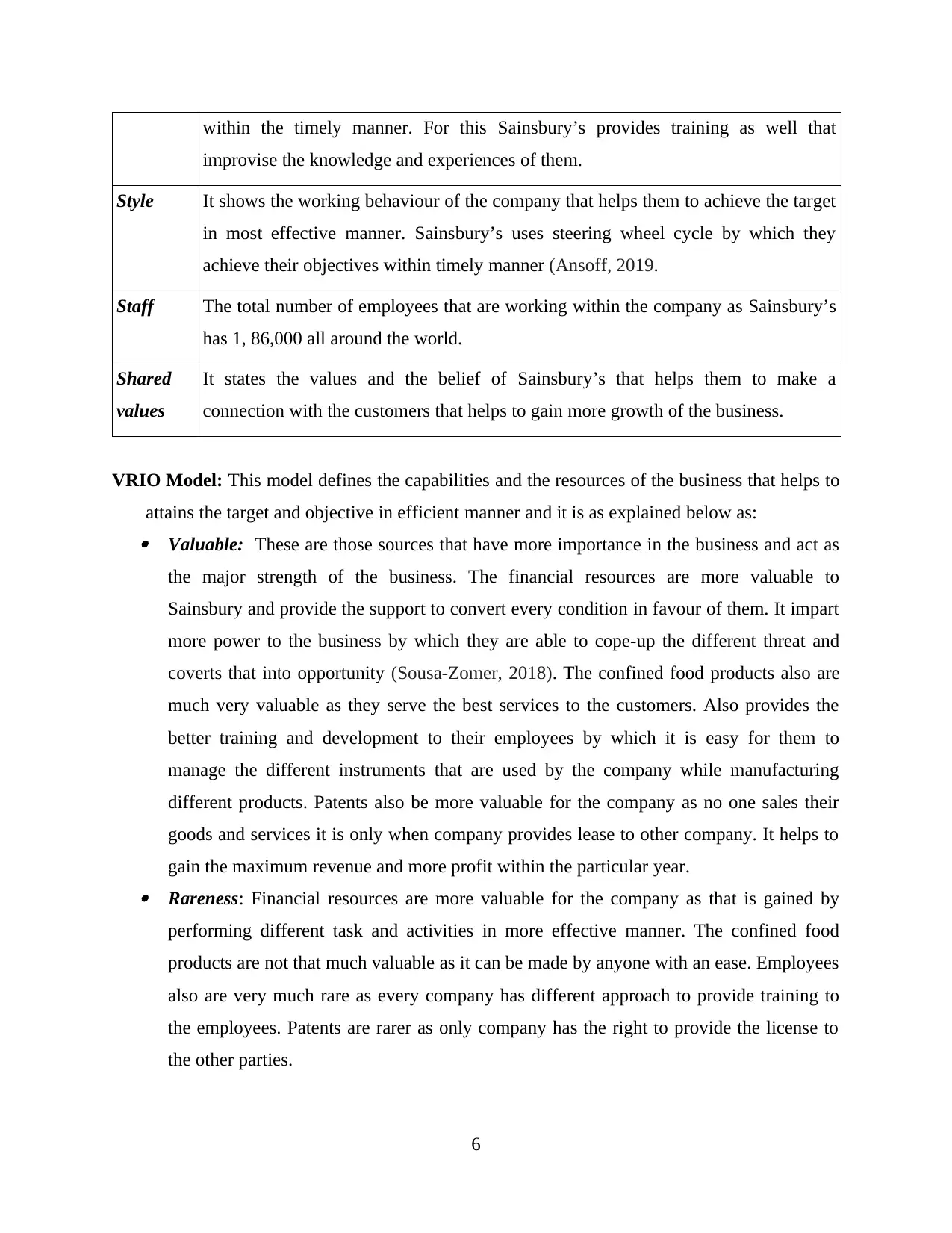
within the timely manner. For this Sainsbury’s provides training as well that
improvise the knowledge and experiences of them.
Style It shows the working behaviour of the company that helps them to achieve the target
in most effective manner. Sainsbury’s uses steering wheel cycle by which they
achieve their objectives within timely manner (Ansoff, 2019.
Staff The total number of employees that are working within the company as Sainsbury’s
has 1, 86,000 all around the world.
Shared
values
It states the values and the belief of Sainsbury’s that helps them to make a
connection with the customers that helps to gain more growth of the business.
VRIO Model: This model defines the capabilities and the resources of the business that helps to
attains the target and objective in efficient manner and it is as explained below as: Valuable: These are those sources that have more importance in the business and act as
the major strength of the business. The financial resources are more valuable to
Sainsbury and provide the support to convert every condition in favour of them. It impart
more power to the business by which they are able to cope-up the different threat and
coverts that into opportunity (Sousa-Zomer, 2018). The confined food products also are
much very valuable as they serve the best services to the customers. Also provides the
better training and development to their employees by which it is easy for them to
manage the different instruments that are used by the company while manufacturing
different products. Patents also be more valuable for the company as no one sales their
goods and services it is only when company provides lease to other company. It helps to
gain the maximum revenue and more profit within the particular year. Rareness: Financial resources are more valuable for the company as that is gained by
performing different task and activities in more effective manner. The confined food
products are not that much valuable as it can be made by anyone with an ease. Employees
also are very much rare as every company has different approach to provide training to
the employees. Patents are rarer as only company has the right to provide the license to
the other parties.
6
improvise the knowledge and experiences of them.
Style It shows the working behaviour of the company that helps them to achieve the target
in most effective manner. Sainsbury’s uses steering wheel cycle by which they
achieve their objectives within timely manner (Ansoff, 2019.
Staff The total number of employees that are working within the company as Sainsbury’s
has 1, 86,000 all around the world.
Shared
values
It states the values and the belief of Sainsbury’s that helps them to make a
connection with the customers that helps to gain more growth of the business.
VRIO Model: This model defines the capabilities and the resources of the business that helps to
attains the target and objective in efficient manner and it is as explained below as: Valuable: These are those sources that have more importance in the business and act as
the major strength of the business. The financial resources are more valuable to
Sainsbury and provide the support to convert every condition in favour of them. It impart
more power to the business by which they are able to cope-up the different threat and
coverts that into opportunity (Sousa-Zomer, 2018). The confined food products also are
much very valuable as they serve the best services to the customers. Also provides the
better training and development to their employees by which it is easy for them to
manage the different instruments that are used by the company while manufacturing
different products. Patents also be more valuable for the company as no one sales their
goods and services it is only when company provides lease to other company. It helps to
gain the maximum revenue and more profit within the particular year. Rareness: Financial resources are more valuable for the company as that is gained by
performing different task and activities in more effective manner. The confined food
products are not that much valuable as it can be made by anyone with an ease. Employees
also are very much rare as every company has different approach to provide training to
the employees. Patents are rarer as only company has the right to provide the license to
the other parties.
6
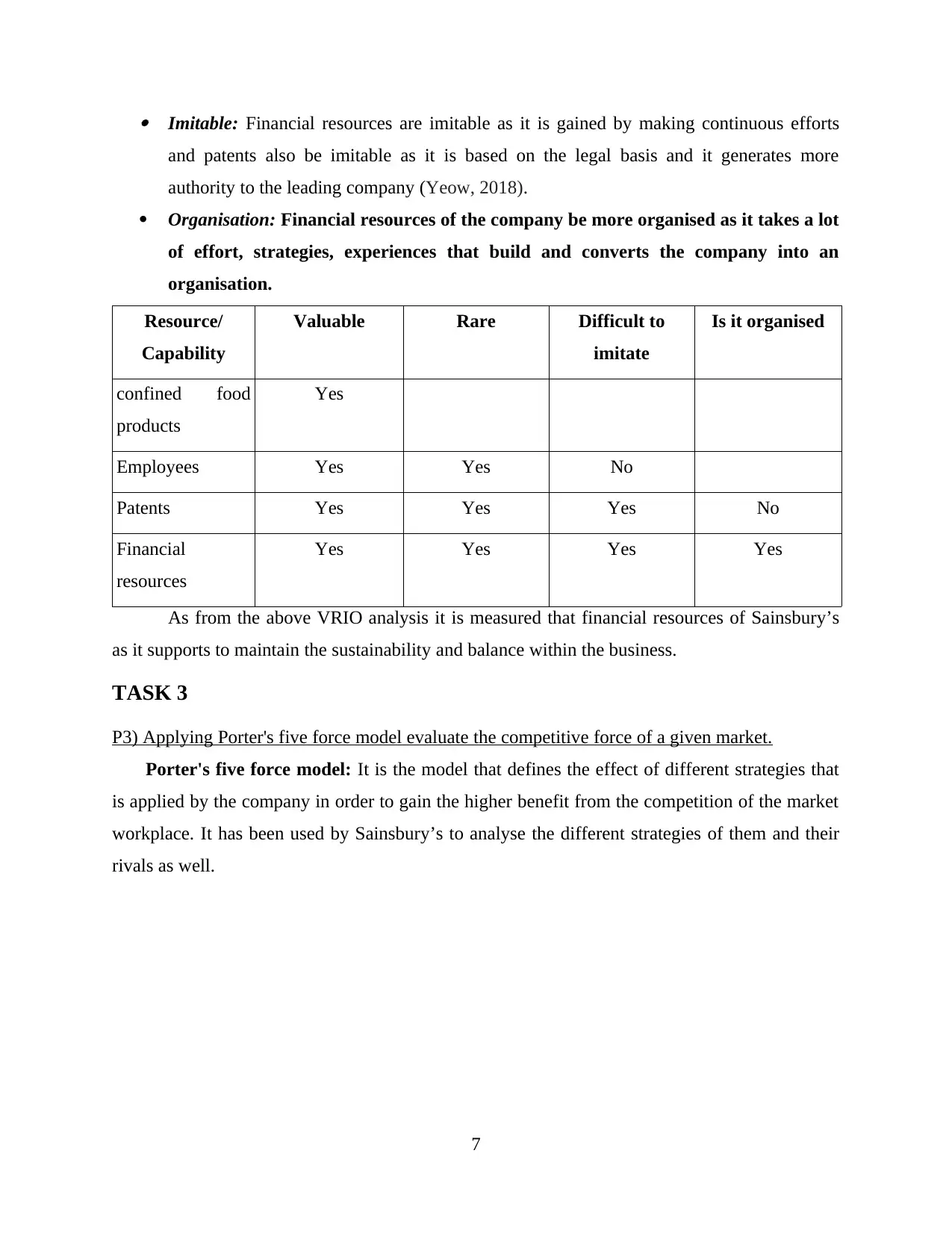
Imitable: Financial resources are imitable as it is gained by making continuous efforts
and patents also be imitable as it is based on the legal basis and it generates more
authority to the leading company (Yeow, 2018).
Organisation: Financial resources of the company be more organised as it takes a lot
of effort, strategies, experiences that build and converts the company into an
organisation.
Resource/
Capability
Valuable Rare Difficult to
imitate
Is it organised
confined food
products
Yes
Employees Yes Yes No
Patents Yes Yes Yes No
Financial
resources
Yes Yes Yes Yes
As from the above VRIO analysis it is measured that financial resources of Sainsbury’s
as it supports to maintain the sustainability and balance within the business.
TASK 3
P3) Applying Porter's five force model evaluate the competitive force of a given market.
Porter's five force model: It is the model that defines the effect of different strategies that
is applied by the company in order to gain the higher benefit from the competition of the market
workplace. It has been used by Sainsbury’s to analyse the different strategies of them and their
rivals as well.
7
and patents also be imitable as it is based on the legal basis and it generates more
authority to the leading company (Yeow, 2018).
Organisation: Financial resources of the company be more organised as it takes a lot
of effort, strategies, experiences that build and converts the company into an
organisation.
Resource/
Capability
Valuable Rare Difficult to
imitate
Is it organised
confined food
products
Yes
Employees Yes Yes No
Patents Yes Yes Yes No
Financial
resources
Yes Yes Yes Yes
As from the above VRIO analysis it is measured that financial resources of Sainsbury’s
as it supports to maintain the sustainability and balance within the business.
TASK 3
P3) Applying Porter's five force model evaluate the competitive force of a given market.
Porter's five force model: It is the model that defines the effect of different strategies that
is applied by the company in order to gain the higher benefit from the competition of the market
workplace. It has been used by Sainsbury’s to analyse the different strategies of them and their
rivals as well.
7
⊘ This is a preview!⊘
Do you want full access?
Subscribe today to unlock all pages.

Trusted by 1+ million students worldwide
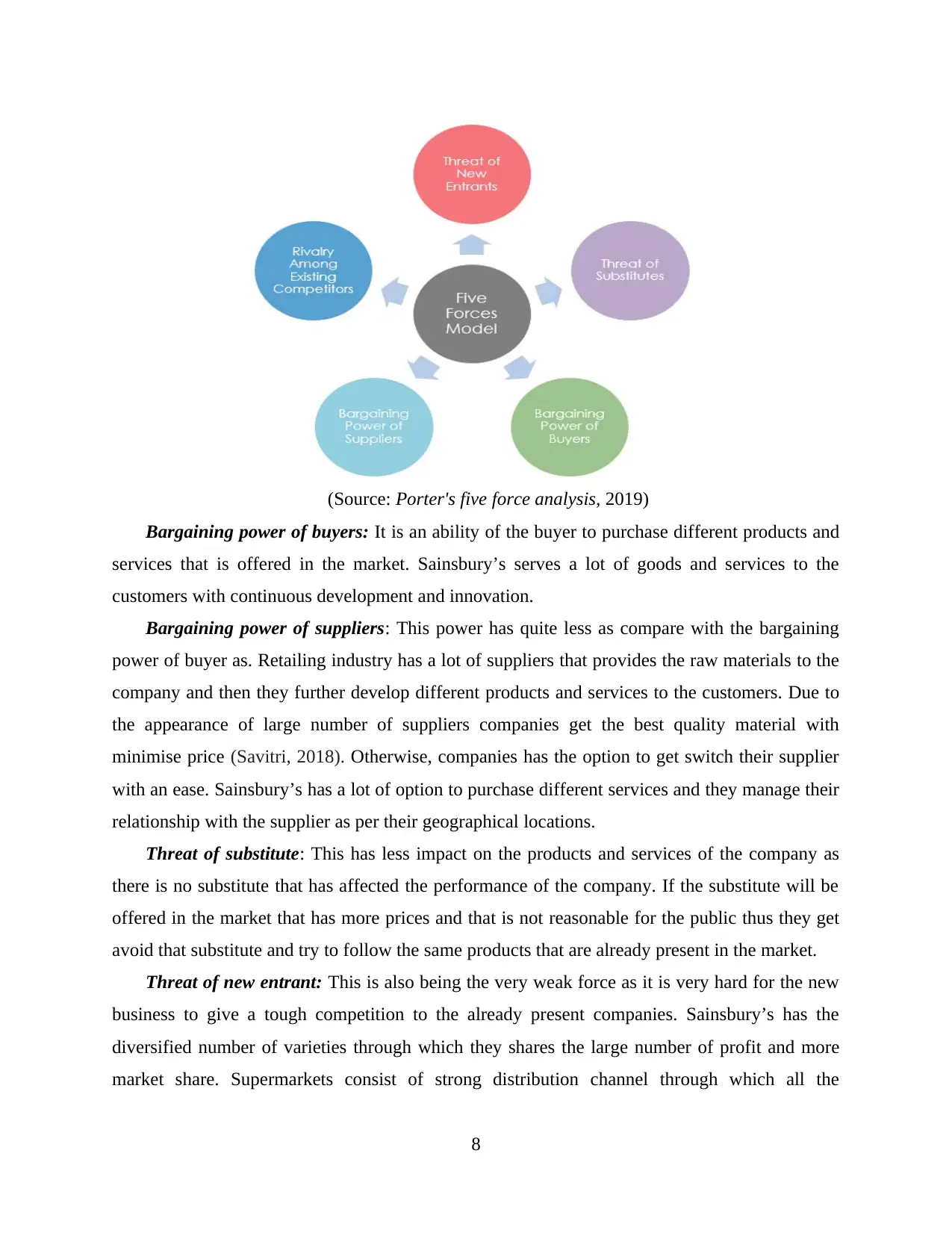
(Source: Porter's five force analysis, 2019)
Bargaining power of buyers: It is an ability of the buyer to purchase different products and
services that is offered in the market. Sainsbury’s serves a lot of goods and services to the
customers with continuous development and innovation.
Bargaining power of suppliers: This power has quite less as compare with the bargaining
power of buyer as. Retailing industry has a lot of suppliers that provides the raw materials to the
company and then they further develop different products and services to the customers. Due to
the appearance of large number of suppliers companies get the best quality material with
minimise price (Savitri, 2018). Otherwise, companies has the option to get switch their supplier
with an ease. Sainsbury’s has a lot of option to purchase different services and they manage their
relationship with the supplier as per their geographical locations.
Threat of substitute: This has less impact on the products and services of the company as
there is no substitute that has affected the performance of the company. If the substitute will be
offered in the market that has more prices and that is not reasonable for the public thus they get
avoid that substitute and try to follow the same products that are already present in the market.
Threat of new entrant: This is also being the very weak force as it is very hard for the new
business to give a tough competition to the already present companies. Sainsbury’s has the
diversified number of varieties through which they shares the large number of profit and more
market share. Supermarkets consist of strong distribution channel through which all the
8
Bargaining power of buyers: It is an ability of the buyer to purchase different products and
services that is offered in the market. Sainsbury’s serves a lot of goods and services to the
customers with continuous development and innovation.
Bargaining power of suppliers: This power has quite less as compare with the bargaining
power of buyer as. Retailing industry has a lot of suppliers that provides the raw materials to the
company and then they further develop different products and services to the customers. Due to
the appearance of large number of suppliers companies get the best quality material with
minimise price (Savitri, 2018). Otherwise, companies has the option to get switch their supplier
with an ease. Sainsbury’s has a lot of option to purchase different services and they manage their
relationship with the supplier as per their geographical locations.
Threat of substitute: This has less impact on the products and services of the company as
there is no substitute that has affected the performance of the company. If the substitute will be
offered in the market that has more prices and that is not reasonable for the public thus they get
avoid that substitute and try to follow the same products that are already present in the market.
Threat of new entrant: This is also being the very weak force as it is very hard for the new
business to give a tough competition to the already present companies. Sainsbury’s has the
diversified number of varieties through which they shares the large number of profit and more
market share. Supermarkets consist of strong distribution channel through which all the
8
Paraphrase This Document
Need a fresh take? Get an instant paraphrase of this document with our AI Paraphraser
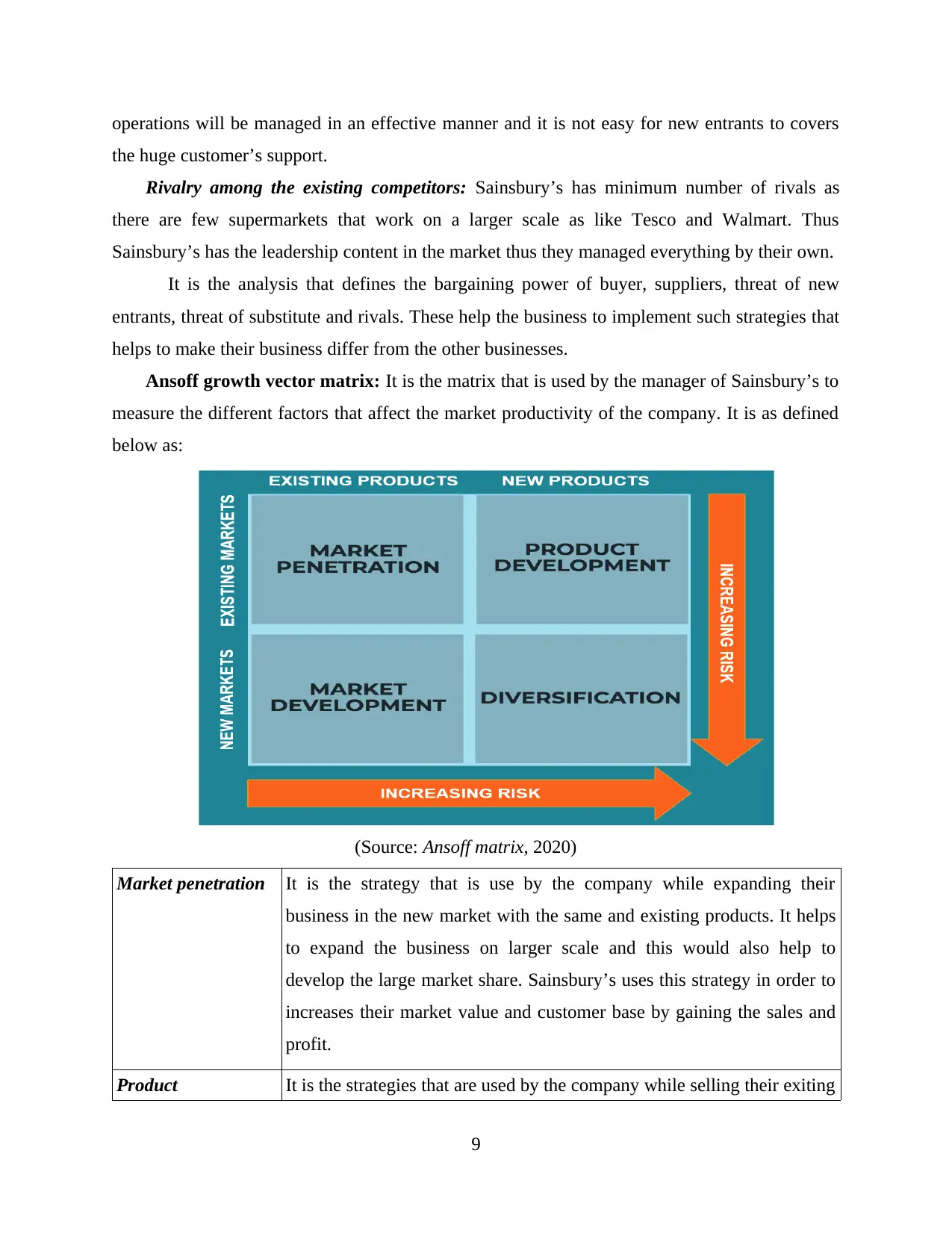
operations will be managed in an effective manner and it is not easy for new entrants to covers
the huge customer’s support.
Rivalry among the existing competitors: Sainsbury’s has minimum number of rivals as
there are few supermarkets that work on a larger scale as like Tesco and Walmart. Thus
Sainsbury’s has the leadership content in the market thus they managed everything by their own.
It is the analysis that defines the bargaining power of buyer, suppliers, threat of new
entrants, threat of substitute and rivals. These help the business to implement such strategies that
helps to make their business differ from the other businesses.
Ansoff growth vector matrix: It is the matrix that is used by the manager of Sainsbury’s to
measure the different factors that affect the market productivity of the company. It is as defined
below as:
(Source: Ansoff matrix, 2020)
Market penetration It is the strategy that is use by the company while expanding their
business in the new market with the same and existing products. It helps
to expand the business on larger scale and this would also help to
develop the large market share. Sainsbury’s uses this strategy in order to
increases their market value and customer base by gaining the sales and
profit.
Product It is the strategies that are used by the company while selling their exiting
9
the huge customer’s support.
Rivalry among the existing competitors: Sainsbury’s has minimum number of rivals as
there are few supermarkets that work on a larger scale as like Tesco and Walmart. Thus
Sainsbury’s has the leadership content in the market thus they managed everything by their own.
It is the analysis that defines the bargaining power of buyer, suppliers, threat of new
entrants, threat of substitute and rivals. These help the business to implement such strategies that
helps to make their business differ from the other businesses.
Ansoff growth vector matrix: It is the matrix that is used by the manager of Sainsbury’s to
measure the different factors that affect the market productivity of the company. It is as defined
below as:
(Source: Ansoff matrix, 2020)
Market penetration It is the strategy that is use by the company while expanding their
business in the new market with the same and existing products. It helps
to expand the business on larger scale and this would also help to
develop the large market share. Sainsbury’s uses this strategy in order to
increases their market value and customer base by gaining the sales and
profit.
Product It is the strategies that are used by the company while selling their exiting
9
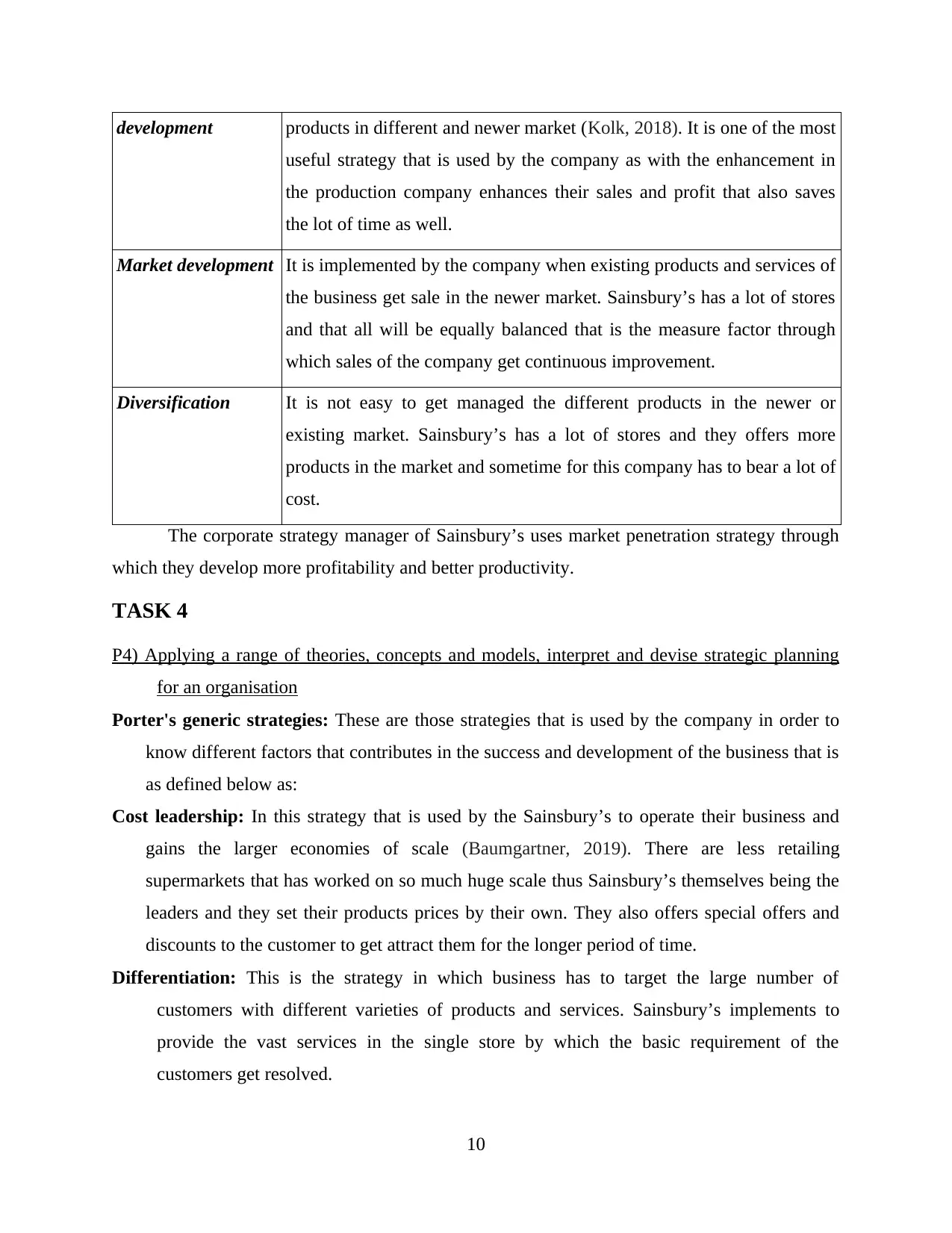
development products in different and newer market (Kolk, 2018). It is one of the most
useful strategy that is used by the company as with the enhancement in
the production company enhances their sales and profit that also saves
the lot of time as well.
Market development It is implemented by the company when existing products and services of
the business get sale in the newer market. Sainsbury’s has a lot of stores
and that all will be equally balanced that is the measure factor through
which sales of the company get continuous improvement.
Diversification It is not easy to get managed the different products in the newer or
existing market. Sainsbury’s has a lot of stores and they offers more
products in the market and sometime for this company has to bear a lot of
cost.
The corporate strategy manager of Sainsbury’s uses market penetration strategy through
which they develop more profitability and better productivity.
TASK 4
P4) Applying a range of theories, concepts and models, interpret and devise strategic planning
for an organisation
Porter's generic strategies: These are those strategies that is used by the company in order to
know different factors that contributes in the success and development of the business that is
as defined below as:
Cost leadership: In this strategy that is used by the Sainsbury’s to operate their business and
gains the larger economies of scale (Baumgartner, 2019). There are less retailing
supermarkets that has worked on so much huge scale thus Sainsbury’s themselves being the
leaders and they set their products prices by their own. They also offers special offers and
discounts to the customer to get attract them for the longer period of time.
Differentiation: This is the strategy in which business has to target the large number of
customers with different varieties of products and services. Sainsbury’s implements to
provide the vast services in the single store by which the basic requirement of the
customers get resolved.
10
useful strategy that is used by the company as with the enhancement in
the production company enhances their sales and profit that also saves
the lot of time as well.
Market development It is implemented by the company when existing products and services of
the business get sale in the newer market. Sainsbury’s has a lot of stores
and that all will be equally balanced that is the measure factor through
which sales of the company get continuous improvement.
Diversification It is not easy to get managed the different products in the newer or
existing market. Sainsbury’s has a lot of stores and they offers more
products in the market and sometime for this company has to bear a lot of
cost.
The corporate strategy manager of Sainsbury’s uses market penetration strategy through
which they develop more profitability and better productivity.
TASK 4
P4) Applying a range of theories, concepts and models, interpret and devise strategic planning
for an organisation
Porter's generic strategies: These are those strategies that is used by the company in order to
know different factors that contributes in the success and development of the business that is
as defined below as:
Cost leadership: In this strategy that is used by the Sainsbury’s to operate their business and
gains the larger economies of scale (Baumgartner, 2019). There are less retailing
supermarkets that has worked on so much huge scale thus Sainsbury’s themselves being the
leaders and they set their products prices by their own. They also offers special offers and
discounts to the customer to get attract them for the longer period of time.
Differentiation: This is the strategy in which business has to target the large number of
customers with different varieties of products and services. Sainsbury’s implements to
provide the vast services in the single store by which the basic requirement of the
customers get resolved.
10
⊘ This is a preview!⊘
Do you want full access?
Subscribe today to unlock all pages.

Trusted by 1+ million students worldwide
1 out of 17
Related Documents
Your All-in-One AI-Powered Toolkit for Academic Success.
+13062052269
info@desklib.com
Available 24*7 on WhatsApp / Email
![[object Object]](/_next/static/media/star-bottom.7253800d.svg)
Unlock your academic potential
Copyright © 2020–2025 A2Z Services. All Rights Reserved. Developed and managed by ZUCOL.





